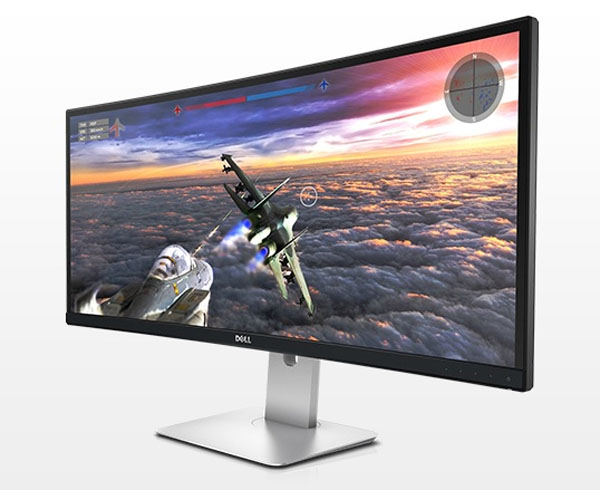Early Verdict
Curved monitors may still leave some buyers scratching their heads but in our opinion, they’re quite useful and worth the extra money. The U3415W offers quality and accuracy that easily justify its price so we consider the ultra-wide aspect and curved screen to be bonuses. If you really want to know what they’re all about, try one out before buying. We have no trouble recommending this one to professionals or enthusiasts alike
Pros
- +
Out-of-box accuracy
- +
Brightness
- +
Sharpness
- +
Full-featured OSD
- +
Build quality
- +
Screen real estate
- +
Curved screen
- +
Input lag
- +
Viewing angle
Cons
- -
Minor gamma flaws
Why you can trust Tom's Hardware
Introduction
CES saw the announcement of a new category in displays, monitors with curved screens. Since LG makes most of the parts for this category, it’s only fitting that the company should be the first to market with the 34UC97, which we reviewed in January. It’s a 21:9-aspect IPS panel with 3440x1440 resolution currently selling for around $1000.
Samsung, HP and Dell also announced curved monitors back in January and today we’re taking our first look at Dell’s entry, the U3415W. Coming in at the same price point, it sports professional credentials with factory calibration, a large and flexible OSD, high contrast from an IPS panel and premium build quality.
Specifications
Reaction to the advent of curved monitors has been mainly centered on one question, “why?” When 21:9 screens first appeared in 2013, we wondered if they were the answer to a question no one had asked. Of course, that was a reference to the 29-inch AOC Q2963PM, which has a less-useful 2560x1080 pixel resolution. That panel tends to squeeze desktop height a little too much for our tastes.
Then LG shipped us its 34UM95. With 3440x1440 pixels, it offers the same 109ppi density and the same screen height as our favorite 27-inch QHD form factor, plus the added width. That makes for a truly versatile display that can redefine how you multi-task, and it easily accommodates dual-source picture-by-picture setups. And well-heeled gamers can set up two or three ultra-wide displays for an incredibly immersive experience.
By curving the screen just a little, the extra width fits better into the user’s peripheral vision, and reduces the amount of head-turning necessary to see the entire desktop. Product photos seem to exaggerate the curve somewhat. In reality, it’s fairly subtle — the image is not distorted in any way.
Dell has upped the ante just a bit with the U3415W. A factory calibration is the first major feature that leaps out, confirmed by a data sheet included with, and unique to, each display. You’ll see in our tests that this monitor is one of the most accurate we’ve ever tested, before and after calibration.
There are also four video inputs and two USB upstream ports, which makes it easy to connect two computers and have them share a single monitor, keyboard and mouse. MHL support allows the mirroring of smartphone and tablet content, as well as charging of those devices, and there’s even an HDMI 2.0 port which accepts a native 3440x1440 signal at 60Hz.
Get Tom's Hardware's best news and in-depth reviews, straight to your inbox.
MORE: Best Computer MonitorsMORE: Display Calibration 101: Step-By-Step With Datacolor's Sypder4Elite
MORE: Display Calibration 201: The Science Behind Tuning Your Monitor
MORE: All Monitor ArticlesMORE: Displays on the Forums

Christian Eberle is a Contributing Editor for Tom's Hardware US. He's a veteran reviewer of A/V equipment, specializing in monitors. Christian began his obsession with tech when he built his first PC in 1991, a 286 running DOS 3.0 at a blazing 12MHz. In 2006, he undertook training from the Imaging Science Foundation in video calibration and testing and thus started a passion for precise imaging that persists to this day. He is also a professional musician with a degree from the New England Conservatory as a classical bassoonist which he used to good effect as a performer with the West Point Army Band from 1987 to 2013. He enjoys watching movies and listening to high-end audio in his custom-built home theater and can be seen riding trails near his home on a race-ready ICE VTX recumbent trike. Christian enjoys the endless summer in Florida where he lives with his wife and Chihuahua and plays with orchestras around the state.
-
tom10167 "3440x2160" Anyone else getting tired of seeing this site report glaring errors in almost everything they publish?Reply -
SirGCal Unless I missed it, no mention of sync of either flavor. I'm not buying a new display without one or the other. I've noticed it so much nicer in every enabled task, not just gaming.Reply -
HideOut Thats not 4K. and no, it has no sync. This is more of a pro grade monitor, not a high FPS gamerReply -
GoZFast Well, too bad, its 1220$ here in Canada. I guess I will add it to my list when shopping in NY next time lol Dell brand 34'' ~4K monitor 10bit pro panel with ok speakers is pretty decent for 799$. Its a good tv with those inputs for a small room.Reply -
Tanquen IPS = :)Reply
Curved = :(
21:9 = :(
34” = :( It’s too darn short for a widescreen display. My 30” 2560x1600 already has a taller res.
“By curving the screen just a little, the extra width fits better into the user’s peripheral vision, and reduces the amount of head-turning necessary to see the entire desktop.” Wow, just wow! This is just so wrong.
“the image is not distorted in any way.”
It may not be enough to notice but it totally distorts the screen and nothing you view on it will be shot in such a way. The larger TVs totally have a bowtie effect going on and it’s a total gimmick.
